

In recent years, Baltic countries have experienced a solar power boom, and the region hopes to achieve two goals with one stone. Amidst growing security concerns, these countries aim to break free from years of energy dependence on Russia while continuing to prioritize the transition to green energy. The outbreak of hostilities in Ukraine has sounded the alarm for the Baltic States, indicating their urgent need to change energy policies. The Baltic countries of Latvia, Lithuania, and Estonia have learned a lot from Ukraine's unfortunate experience, as they also have to live in the shadow of their belligerent eastern neighbors. Most European countries used to rely to some extent on Russia's energy, but for Baltic countries, this issue is different. These three countries still belong to the "BRELL" line of the Soviet era, and Russia and Belarus rely on Russian operators to control frequency and balance supply and demand. In 2018, Latvia, Lithuania, and Estonia finalized a plan to leave BRELL and join the EU grid by the end of 2025. The events in Ukraine have forced these countries to reconsider their schedules and accelerate the transition. Other measures need to be taken to improve the safety of its power grid. In addition to political reasons, with the soaring energy costs in the Baltic region, Baltic investors have gained a strong economic motivation to invest in solar energy. At the height of the energy crisis in Europe in 2022, the bills of electricity consumers increased nearly seven times compared to the previous year. In this context, the growth of solar power generation in the Baltic Sea region from 2022 to 2024 even exceeded the most optimistic predictions. Estonia has indeed made significant progress in the development of photovoltaic power generation. Mikel Anus, President of the Estonian Renewable Energy Association, stated that installed capacity doubles every year. In just five years, as of the end of 2023, the total installed capacity of solar energy has increased from 39.6 MW in 2018 to 812 MW. According to data from the Lithuanian Energy Agency (LEA), Lithuania exceeded its target of 1.2 gigawatts of solar power generation by 2025 in 2023. In the past few years, the country has generated nearly 300 megawatts of new electricity. Anna Roz ī te, Business Development Director of AJ Power Group, stated that as of January 2024, Latvia's solar installed capacity is approximately 300 megawatts. Since May 2023 alone, this number has increased by about three times. Due to market participants mainly choosing solutions that can be implemented as soon as possible, solar energy has ushered in an investment boom in Latvia and other Baltic countries.
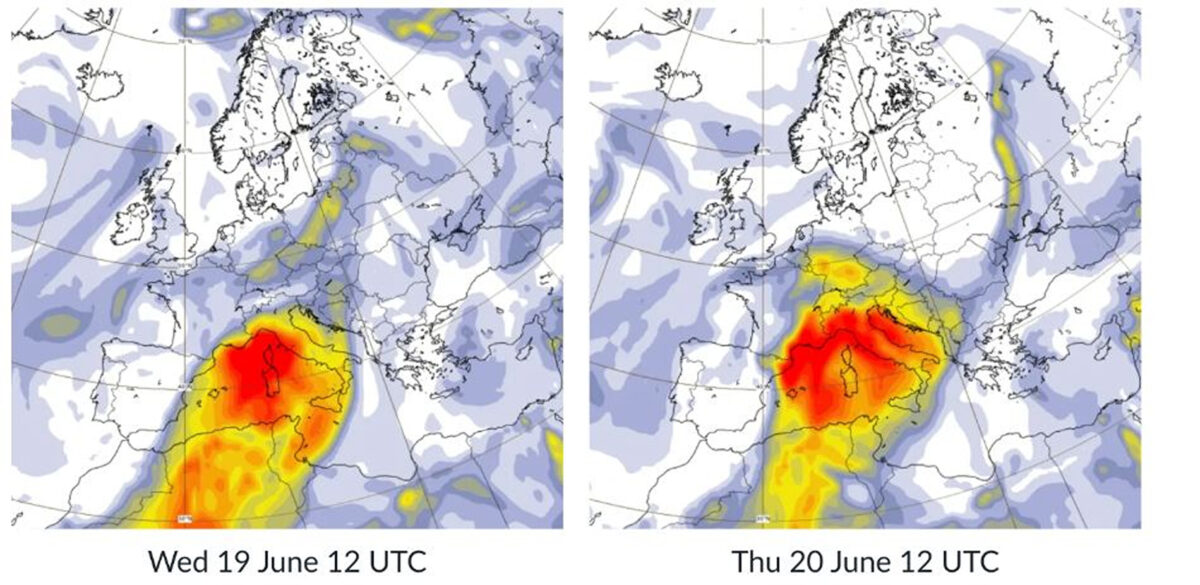
Sahara dust has entered the atmosphere, affecting solar power generation in various parts of Europe by up to 20%. This type of dust cloud is quite common and can reduce clear sky irradiance (leading to solar power generation) by up to 20%, but fortunately, this situation will only last for a few days. According to the analysis using the Solcast API, this week's dust clouds will dissipate on Saturday, reducing the impact on areas further north and mountainous areas protected by the Alps. The low-pressure system over the Mediterranean has triggered a serious sand and dust transport event, affecting solar power generation throughout Europe for the entire week. The weak low-pressure system in the Mediterranean forms a southerly wind, which passes through the Mediterranean from Sahara Africa and enters Europe, blowing sand and dust into southern Italy and France. The high-pressure ridge from the Atlantic forms a westerly wind, blowing sand and dust from the northern Alps into southern Germany. By Saturday, the intensity of sand and dust will greatly decrease, mixing and dispersing with the upper atmosphere, thus being diluted. The impact on clear sky irradiance is very significant, with the global level of clear sky irradiance (GHI) in Marseille decreasing by more than 20% compared to the average level. In summer, it is not uncommon for Sahara dust transport to cross the Mediterranean, as the Azores high-pressure system moves northward, creating more low-pressure systems in the Mediterranean. That's why Italy, which extends to the Mediterranean, is usually more susceptible to the impact of such dust transport.
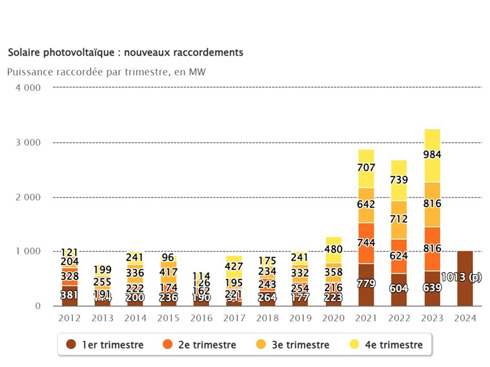
The French Ministry of Ecological Transformation reported that approximately 1013 MW of new photovoltaic power generation systems were successfully connected to the grid in France from January to March this year. In contrast, the country's installed capacity in the fourth quarter of 2023 was 984 MW, compared to an additional 639 MW in the first quarter of last year. As of the end of March 2024, France's cumulative photovoltaic installed capacity has reached 21.1 GW. Among them, major developers have deployed approximately 20.3 GW in mainland France, while the rest are distributed in Corsica and French overseas territories. At present, the total capacity of solar projects queuing up for grid connection is 27.3 GW, of which approximately 6.3 GW have already signed preliminary grid connection agreements. The new Aquitaine region, Auvergne Rh ô ne Alpes region, Provence Alpes Blue Coast region, and the Greater East region of France account for 47% of the total new installed capacity so far this year. These regions with the largest installed capacity account for over 53% of France's cumulative grid connected capacity as of the end of March.
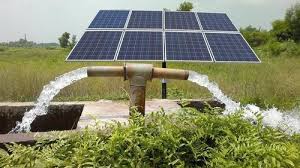
The Philippine government has put into operation the largest solar irrigation system in the Philippines, consisting of more than 1,000 solar panels and two submersible pumps. The project, built between July 2023 and February 2024, cost 65.7 million Philippine pesos ($1.1 million) and has more than 1,000 solar panels. Its two submersible pumps can produce 739,200 watts of power, and each pump can drain 12,800 gallons (48,453 liters) per minute. Philippine President Ferdinand R. Marcos Jr. said the project is the largest solar pumped irrigation project in the Philippines to date, irrigating 350 hectares of rice fields and helping nearly 237 farmers. Isabela Province is the largest corn producing region and the second largest rice producing region in the Philippines. The project is the first in the Philippines to be built on irrigation canals, meaning there will be no less land for farmers to cultivate. President Marcos said another 152 solar water pump irrigation projects are under construction across the country, including 118 government-regulated projects. At the same time, 82 solar irrigation projects have been built and put into use since 2023.
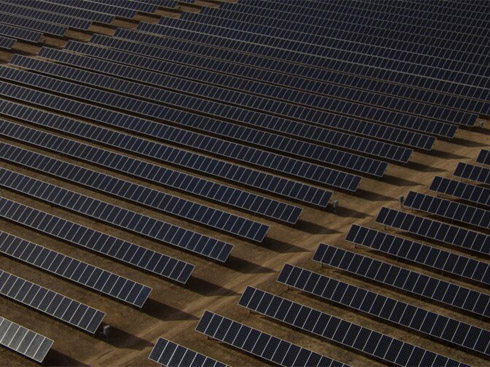
The International Energy Agency (IEA) has released a new report saying that the world is likely to miss the target of expanding global renewable energy capacity to 11,000 GW by 2030, agreed at the 28th Conference of the Parties to the United Nations Framework Convention on Climate Change (COP28). The report also predicts that solar power will overtake hydropower to account for the largest share of the world's installed renewable energy capacity. The IEA reports that national governments have set domestic renewable energy ambitions that exceed those of the NDC. The agency's analysis of policies, plans and estimates from nearly 150 countries shows that nearly 8,000 GW of renewable energy will be installed globally by 2030, accounting for 70% of the capacity needed to achieve the tripling target by 2030. The IEA said that in order to reach 11,000 GW, most regions and countries, including the European Union, the United States and India, "need to accelerate" the pace of deployment. Southeast Asia, the Middle East, North Africa and sub-Saharan Africa require increased deployment, according to the report. The report also notes that China's renewable energy expansion is critical to achieving the 11,000 GW target, with the country so far on track to exceed the 2030 target by 2.5 times. Since the signing of the Paris Agreement in 2015, new annual renewable energy capacity has tripled, according to the report. The IEA attributes this achievement to policy support, economies of scale and technological advances. The International Energy Agency has revealed that solar energy accounts for half of the future capacity that governments have clearly mapped out. It predicts that once countries meet their 2030 targets, the sun will overtake hydropower to become the world's largest source of installed renewable energy capacity. The report also identifies key challenges to renewable energy deployment, including long waiting times for approvals, inadequate investment in grid infrastructure, the need for rapid and efficient integration of variable renewables, and high financing costs, especially for emerging and developing economies. It calls for lower financing costs to improve the financing viability of renewable energy projects and to provide project support in the pre-development stage. In April, the International Energy Agency called for a six-fold increase in global energy storage capacity to drive the 2030 global goal.
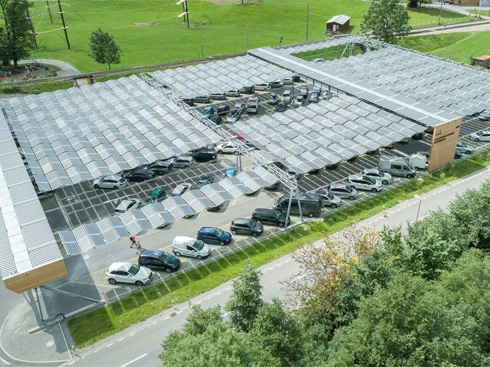
Swiss voters have approved a new electricity regulation that makes it mandatory for large buildings to install photovoltaic systems to support the power community and encourage collective energy self-use. Some 68.72% of Swiss voted in favour of new electricity regulations to speed up the development of renewable energy. The law provides new incentives for the development of photovoltaic power generation, and new buildings with a surface of more than 300 square meters must install solar installations on the roof or external walls. States may extend this requirement to buildings with a floor area of not more than 300 square meters. Swissolar, a Swiss industry association, said in a press release: "The Ministry's electricity law lays the necessary foundation for continued growth in solar power generation - mainly located in buildings and infrastructure and delivered by highly efficient installations in winter." Solar energy will become the second pillar of Switzerland's energy supply, alongside hydropower." The new regulations also support local power communities and expand self-use groups. Distribution network operators must sell more electricity from local renewable sources to customers. According to Swissolar, Switzerland will install more than 1.5 GW of PV systems by 2023.以上翻译结果来自有道神经网络翻译(YNMT)· 通用场景
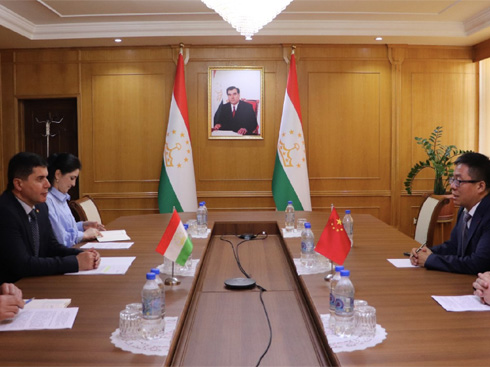
Chinese developer Eging PV Technology said it will build a 200 MW solar power station in southwestern Tajikistan. The project will be developed in four phases, with a $150 million investment in the first phase to build a solar power plant on 250 hectares of land. According to a statement from Tajikistan's Energy Ministry, the total investment in the four phases of the project will amount to $1.5 billion. Tajikistan will also lay the foundation stone for the construction of the country's first solar equipment production plant with the investment of South Korea's Global solar Wafer company. The plant is expected to cost $2 million. Construction of the plant will begin in July, with the first of four phases scheduled to be completed by March 2025. According to a statement from the presidential press Service, the initial manufacturing capacity of the plant is expected to reach 5,000 MW. Once fully operational, the plant will provide 8,000 jobs, 95 percent of which will be allocated to Tajik citizens. In October 2023, Tajikistan announced plans for 500 MW of renewable energy, including floating photovoltaic installations, and set a target of 1 GW of renewable energy generation by 2030. According to the International Renewable Energy Agency (IRENA), Tajikistan does not have any installed PV capacity at the end of 2023.
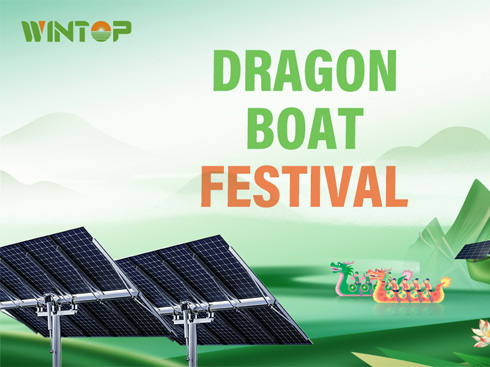
Dear customer: Hello! Thank you for your continuous support and love towards our company. Loong Boat Festival is a traditional festival in China. In order to promote the traditional culture of the Chinese nation and provide employees with a happy holiday, Wintop will make holiday arrangements and notify you in advance as follows: According to the national statutory holiday arrangements, our company will have a Loong Boat Festival holiday from June 8 to June 10, a total of 3 days. During this period, our company will suspend normal business and services, and the specific arrangements are as follows: All office affairs will be suspended during the holiday period. If there are any urgent matters, please leave a message or send an email to our relevant department. We will reply to you as soon as the holiday ends. We sincerely appreciate your trust and support in our company, and we apologize for any inconvenience caused. During this period, please feel free to contact us if you have any emergency situations or questions. Finally, I wish you and your family a happy and healthy Loong Boat Festival! Thank you! Sincerely Wintop
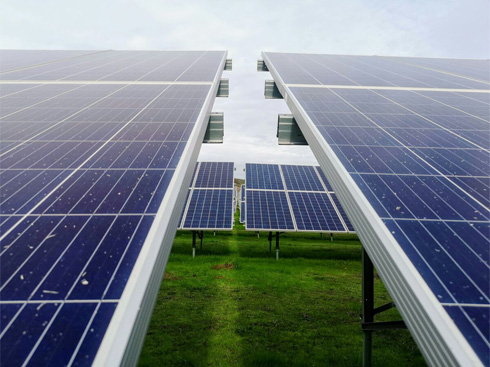
The European Executive Agency for Climate, Infrastructure and the Environment (CINEA) has signed grant agreements with seven solar projects in Finland with a total capacity of 212.99 MW. Following the success of the EU's first cross-border solar tender last year, the EU Renewable Energy Financing Facility has invested a total of €27.5 million in these projects. These include two projects in the South Ostbotten region of western Finland, a 74.03 MW plant in an area currently used for peat production and a 33 MW plant in a peat bog. In addition, the 20-megawatt surface solar park in Loukkaanaro will be the largest solar project in northern Finland and is expected to operate for at least 30 years. Other projects funded include a 40.16 MW power plant in Poytya in southwestern Finland, a 30 MW power park in the city of Tohmajarvi in the North Karelia region of eastern Finland, and an 8 MW power park in the city of Nivala in central Finland Megawatt power plant and a 7.8-megawatt power plant in the city of Savonlinna in eastern Finland.
Categories
New Products
Tin Roof Rapid Solar Mounting System with Hanger Bolt Read More
Residential Small Solar Easy Bracket Kit for Home Balcony Read More
Automatic Single Pile Solar Tracker with 10 PV Panels Read More
Angle Adjustable Aluminum Easy Solar Panel Bracket for Garden Read More
Intelligent Single Post Dual Row Solar Tracking System Read More
5000ES Solar Off-Grid Energy Storage Inverter Supplier Read More
Multi Drive Double-Sided Single Axis Tracker System Read More
© Copyright: 2025 Xiamen Wintop New Energy Tech Co., Ltd.. All Rights Reserved.

IPv6 network supported
Friendly Links:
Integrated Solar System